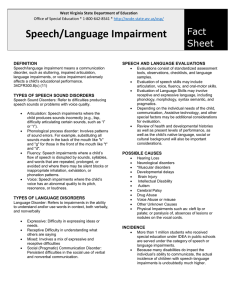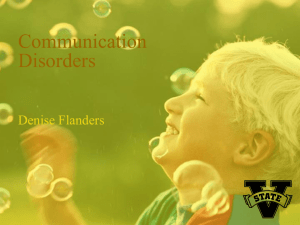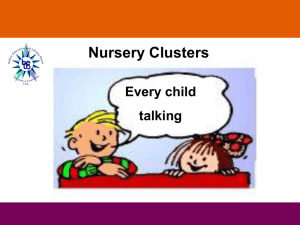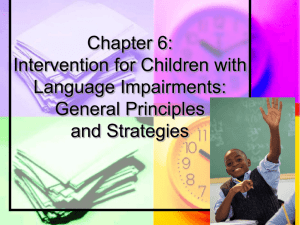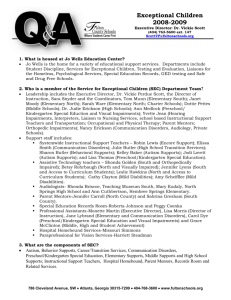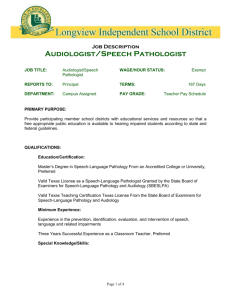speech and language impairment
advertisement
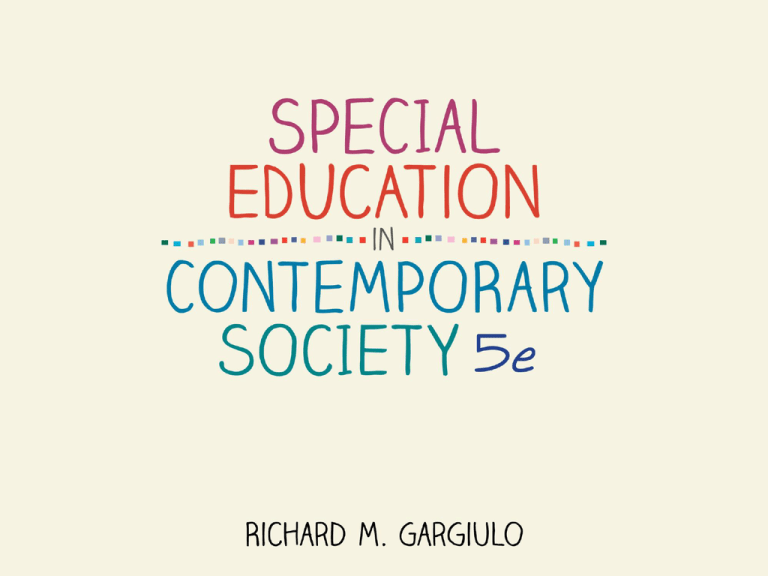
Chapter Eleven Individuals With Speech and Language Impairments Nature of Speech, Language, and Communication Speech: expression of language with sounds Language: rule-based method of communication • Phonology: The sounds characteristic of a language, rules governing their distribution and sequencing, and the stress and intonation patterns that accompany sounds • Morphology: The rules governing how words are formed from the basic element of meaning • Semantics: Rules for how to string words together to form phrases and sentences—the relationships among the elements of a sentence • Syntax: The linguistic realization of what the speaker knows about the world—the meanings of words and sentences • Pragmatics: The social effectiveness of language in achieving desired functions—rules related to the use of language in social contexts • Communication: involves verbal and nonverbal behaviors 3 • https://www.youtube.com/watch?v=BLuZdiX7 Wrg • https://www.youtube.com/watch?v=c7wp0JO PGVo • https://www.youtube.com/watch?v=0CF0M1jEFU 5 6 Defining Speech and Language Impairments • The American Speech-Language-Hearing Association defines a communication disorder as “an impairment in the ability to receive, send, process, and comprehend concepts or verbal, nonverbal, and graphic symbols systems. A communication disorder may be evident in the processes of hearing, language, and/or speech.” • The IDEA WORDING for students with communication difficulties is speech and language impairment and they are eligible for special education if they have “a communication disorder such as stuttering, impaired articulation, a language impairment or a voice impairment, which adversely affect a child’s educational performance 7 Defining Speech and Language Impairments • The IDEA label for students with communication difficulties is speech and language impairment and they are eligible for special education if they have “a communication disorder such as stuttering, impaired articulation, a language impairment or a voice impairment, which adversely affect a child’s educational performance.” Classifying Speech and Language Impairments Speech Disorders – Speech Disorders • Articulation disorders: error in production of sound • Fluency disorders: difficulties with rhythm and timing of speech • Voice disorders: quality of voice is effected Language Disorders • Phonological disorders: Difficulties organizing speech sounds into recognizable patterns • Apraxia of speech: Inability to control the muscles and thoughts that produce speech • Morphological disorders: Adding morphemes incorrectly to words • Semantic disorders: Poor understanding of word meanings, difficulty finding correct words to use • Syntactical deficits: Difficulty with word order and sentence structure • Pragmatic difficulties: Problems understanding and using language in different social contexts Central Auditory Processing Disorders (CAPD) • Difficulty processing (using and interpreting) sounds. CAPD occurs when the ear and brain do not work smoothly together to interpret sounds 9 Historical Perspectives Historical reactions toward individuals with disabilities: • Rejection • Objects of pity • A rewarding sense of humor 10 Prevalence of Speech and Language Impairments – High incidence disability – Often occurs with other disabilities – Almost 20% of children receiving special education receive services for speech and language disorders – Preschoolers with speech and language disorders represent almost half of all preschoolers receiving special education • 11 12 Etiology of Speech and Language Impairments • Functional and organic etiologies ‒ ‒ Functional etiologies have no obvious physical foundations Organic contributions linked to a physiological defect Impairments may be congenital, developmental, or acquired • Aphasia (a loss or impairment of language functions) • Cleft lip or cleft palate (a structural congenital abnormality) • 13 Prevention of Speech and Language Impairments Children typically develop language within acceptable limits • Language is learned in social contexts • Provide early language experiences to infants and young children • Genetic testing may be warranted in some situations • 14 15 Characteristics of Speech and Language Impairments Expressive Language Receptive Language May experience difficulties with: • Limited vocabulary • Incorrect grammar or syntax • Excessive repetition of information • Difficulty formulating questions May experience difficulties with: • Following oral directions • Understanding humor or figurative language • Comprehending complex sentences • Responding to questions appropriately 16 Assessing Speech and Language Impairments Formal and informal measures • Case histories, family interviews, health assessments, observations, developmental information, family dynamics, speech and language assessments Professionals • Teachers, speech-language pathologists, audiologists, neurologists, physicians 17 18 Services for Young Children with Speech and Language Impairments • • • • Early identification importance Early identification procedures Services available from birth to school age Interactions with typically developing peers 19 Adolescents and Adults with Speech and Language Impairments Communication disorders may compound adolescent insecurities • Transition planning for all areas of adult living • 20 Family Issues Speech-language pathologists include families in the assessment and planning process • Speech-language pathologists provide suggestions to families to assist them in helping their children with speech or language impairments • 21 Issues of Diversity • Large numbers of pupils do not speak standard American English as their first language • These students are sometimes described as limited English proficient or English language learners • A lack of reliable and valid tests make it difficult to assess speech and language impairments in children from culturally and linguistically diverse backgrounds 22 Technology and Individuals with Speech and Language Impairments • Augmentative or alternative communication (AAC) ‒ AAC devices may be low-tech or high-tech ‒ These devices are often customized to meet the unique needs of the user 23 Trends, Issues, and Controversies Early intervention • Medical innovations • Cultural and linguistic diversity • Controversies regarding etiologies of speech and language disorders • 24
